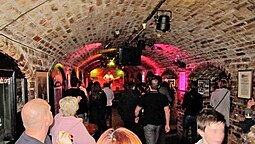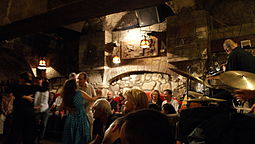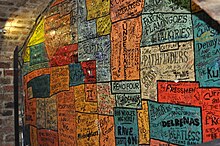The Cavern Club
 The original Cavern Club entrance in 1963 | |
 | |
| Location | Mathew Street, Liverpool, England, United Kingdom |
|---|---|
| Owner | Alan Sytner, Bob Wooler, Ray McFall, Tommy Smith, Bill Heckle, Dave Jones |
| Type | Music venue |
| Genre(s) | Rock ‘n’ roll, Merseybeat, Rock |
| Opened | 16 January 1957, reopened 26 April 1984 and 11 July 1991 |
| Closed | 28 May 1973, and 3 December 1989 |
| Website | |
| www | |
The Cavern Club is a music venue on Mathew Street, Liverpool, England.
The Cavern Club opened on 16 January 1957 as a jazz club, later becoming a centre of the rock and roll scene in Liverpool in the late 50s and early 1960s. The club became closely associated with Merseybeat and regularly played host to The Beatles in their early years.[1]
The Cavern Club closed in 1973 and was filled in during construction work on the Merseyrail underground rail loop. It reopened in 1984. It was temporarily closed again from 1989 to 1991, and has been open ever since.
History of the Cavern Club
[edit]Early history
[edit]Alan Sytner, having been inspired by the jazz district in Paris where there were a number of clubs in cellars, returned to Liverpool and strove to open a club similar to the Le Caveau de la Huchette jazz club. He eventually found a fruit warehouse where people were leasing the cellar, which had been used as an air raid shelter in World War II. Tropical fruit used to be stored there and during warm months the scent from the ripening fruit was absorbed into the sandstone brickwork. When the club was packed with dancing and smoking teenagers, the heat produced resulted in the bricks sweating and the sweet fruit odour was absorbed into their clothing. After leaving, fans at bus stops could be identified as having visited the club by the pleasant 'Cavern Perfume' on their clothes.[citation needed]
The club opened on 16 January 1957 and the first act to perform there was the Merseysippi Jazz Band.[1] Local commercial artist Tony Booth created the poster artwork for the opening night. He later became the original poster artist for the Beatles.
What started as a jazz club eventually became a hangout for skiffle groups. Whilst playing golf with Sytner's father, Dr. Joseph Sytner, Nigel Walley – who had left school at 15 to become an apprentice golf professional at the Lee Park Golf Club – asked Dr. Sytner if his son could book The Quarrymen at The Cavern, which was one of three jazz clubs he managed. Dr. Sytner suggested that the band should play at the golf club first, so as to assess their talent.[2] Sytner phoned Walley a week later and offered the band an interlude spot playing skiffle between the performances of two jazz bands on Wednesday, 7 August 1957.[3]
Before the performance, the Quarrymen argued amongst themselves about the set list, as rock 'n roll songs were definitely not allowed at the club but skiffle was tolerated. After opening with a skiffle song, John Lennon called for the others to start playing an Elvis Presley song, "Don't Be Cruel". Rod Davis warned Lennon that the audience would "eat you alive", but Lennon ignored this and started playing the song himself, forcing the others to join in. Halfway through, Sytner pushed his way through the audience and handed Lennon a note which read, "Cut out the bloody rock 'n roll".[4] Paul McCartney's first appearance at The Cavern was with The Quarrymen on 24 January 1958.[5] George Harrison first played at the Cavern during a lunchtime session on 9 February 1961.[1]
Sytner sold the Cavern Club to Ray McFall in 1959 and moved to London.[1] Blues bands and beat groups began to appear at the club on a regular basis in the early 1960s. The first Beat Night was held on 25 May 1960 and featured a performance by Rory Storm and the Hurricanes (which included Ringo Starr as drummer). By early 1961, Bob Wooler had become the full-time compère and organiser of the lunchtime sessions.[6]
The club hosted its first performance by the Beatles on Thursday, 9 February 1961. Brian Epstein, the Beatles manager who secured the group's first recording contract, first saw the group perform at the club on 9 November 1961. Inspired by the group, Epstein made moves to take over their management.[7]
The Beatles and others
[edit]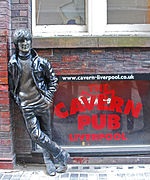
The Beatles made their first appearance at the club on 9 February 1961 after returning to Liverpool from Hamburg, Germany, where they had been playing at the Indra and the Kaiserkeller clubs. Their stage show had been through a lot of changes, with some in the audience thinking they were watching a German band, as they were billed from Hamburg.[citation needed] From 1961 to 1963 the Beatles made 292 appearances at the club, with their last occurring on 3 August 1963, a month after the band recorded "She Loves You" and just six months before the Beatles' first trip to the U.S.[citation needed] By this time "Beatlemania" was sprouting across England, and with girls demanding to see the Beatles and screaming just to get a glimpse of them, the group had to hide or sneak into concerts, and the small club could no longer satisfy audience demand. After the Beatles' farewell gig on 3 August 1963, Bob Wooler gave their future dates to The Mastersounds, a local R&B band, led by Mal Jefferson. The Beatles had graduated from the club and had been signed to EMI's Parlophone label by producer George Martin. The amount of musical activity in Liverpool and Manchester caused record producers who had previously never ventured very far from London to start looking to the north.[citation needed]
In 1963, young local band The Hideaways were signed up to the newly founded Cavern Club agency and became the resident group, often stepping in for last minute artist cancellations; they also became the first pop group to appear on a nationwide television commercial for Timex Watch Company filmed by the Rank Organisation at the Cavern Club. The band also performed at the Cavern the night prior to the club's closure, making them the last group to perform on stage along with disc jockey Billy Butler and doorman Paddy Delaney, who—with fans—barricaded themselves into the club prior to the authorities' arrival the next morning to gain access. The Hideaways were also proactive along with local MP Bessie Braddock to reopen the Cavern; as a result they were the first group back on stage when the club re-opened on 23 July 1966 with local MP Bessie Braddock and then-Prime Minister Harold Wilson. The Hideaways also hold the official record of over 400 Cavern Club appearances at both old and new venues and are now recognised and named on the wall of fame.
In the decade that followed, a wide variety of popular acts appeared at the club, including the Rolling Stones, the Yardbirds, the Hollies, the Kinks, Elton John, Black Sabbath, Queen, the Who and John Lee Hooker.
The song "I Know a Place", a hit for Petula Clark in 1965, twice refers to the club as "a cellar full of noise".
Brian Epstein's 1964 autobiography was entitled "A Cellarful of Noise".
Future singing star Cilla Black worked as the hat-check girl there.
Closing and today
[edit]One of the last groups to play at the club was Focus, with Jan Akkerman, Thijs van Leer, Pierre van der Linden and Bert Ruiter. [11] The club closed on 28 May 1973 after British Rail made a compulsory purchase of the warehouses, the basement of which housed the Cavern Club, in order to build a ventilation shaft for the new Merseyrail underground railway. That was never built, however, and the area was turned into a car park.[12]
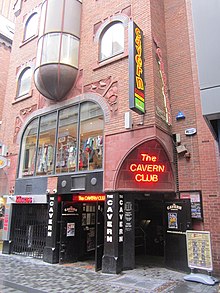
Soon after the Cavern club closed in 1973, a new Cavern club opened at 7 Mathew Street, later renamed the Revolution Club. This club would later shut down and be reopened as Eric's, which itself became a notable local music venue in the late 1970s.
On 7 December 1981 plans were revealed to excavate the buried remains of the Cavern Club cellar. It would form part of a £7-million redevelopment project of the former warehouse site of 8–12 Mathew Street which had housed the Cavern Club up until its closure in 1973. However, on 23 June 1982, it was announced by the project architect, David Backhouse, that the plans to excavate and re-open the Cavern Club in its original form would be impossible for structural reasons. Tests had revealed that the arches of the old cellar had been too badly damaged during the demolition of the ground floor of the Cavern Club and the warehouses above.
5,000 bricks from the damaged archways of the original cellar area of the Cavern Club went on sale at £5 each, complete with an authentication plate signed by former Cavern Club owner Ray McFall. Proceeds from the sale of the 5,000 bricks went to Strawberry Field Children's home.
Before the Cavern Club's opening ceremony, over 100 musicians from the 1960s Mersey Beat era were invited to sign the wall at the back of the Cavern's stage, a tradition which began in the early days of the Jazz bands in the 1950s and continued through the '60s and '70s. A further 15,000 bricks from the Cavern site were used on the authentic reconstruction of the Cavern Club within the redevelopment.
The Cavern Club now sits at a 90-degree angle to the original and covers 70% of the original Cavern footprint, the stage is not far from the original location, and the 'Live Lounge' is an exact replica of the original, using as many of the old bricks as possible.
The fire exit, next to the Cilla Black statue, is the location of the original entrance.
The club was taken over by former Liverpool F.C. player Tommy Smith.[1] The new design was to resemble the original as closely as possible. This coincided with a period of massive economic and political change in and around Liverpool and the club survived only until December 1989, when, following a serious assault on a customer which led to jail sentences for the owners, the Cavern Club lost its licence and was closed by the Licensing Authority. In 1991,[13] two friends—schoolteacher Bill Heckle and taxi driver Dave Jones—reopened it, along with George Guinness on 11 July 1991. They still run the club today and are now the longest-running owners in its history. The club continues to function primarily as a live music venue. The music policy varies from the 1960s, 1970s, 1980s and 1990s classic pop music to indie, rock and modern chart music.[citation needed]
On 14 December 1999, former Beatle Paul McCartney played the New Cavern Club, publicising his new album, Run Devil Run. It has about 40 live bands performing every week; both tribute and original bands, although most perform their own material. The back room of the Cavern is the most frequently used location for touring acts and ticketed events, in more recent times playing host to The Wanted, Adele and Jessie J. The Cavern is also used as a tour warm-up venue with semi-secret gigs announced at the last moment. The Arctic Monkeys did this in October 2005, Jake Bugg in November 2013, as well as Travis and Oasis.[14][15]
The front room is the main tourist attraction, where people come to have their photograph taken on the stage, with the names of the bands who played there written on the back wall. This room hosts live music from noon to midnight Monday to Thursday, and noon to close on Fridays and weekend. Between November 2005 and September 2007, the front room played host to the Cavern Showcase,[16] an organisation and event started by 1960s star Kingsize Taylor, his wife Marga, and best friend Wes Paul. The night took place every Sunday and featured original 1960s bands such as The Mojos and The Undertakers.
In November 2008, a campaign to have Gary Glitter's brick removed from the wall of fame was successful. A brass plaque near where it was located notes that the bricks of two former Cavern Club performers—Glitter and Jonathan King—have been removed.[17]
In 2017,[when?] the Cavern commissioned Tony Booth, the artist who designed all the original posters and signage for the original club, to produce 60th anniversary artwork which portrays bands and musicians who performed there.[18] Also in 2017, a statue of Cilla Black commissioned by her sons was unveiled outside the Cavern's original entrance.[19][20]
In June 2018, Sir Paul McCartney came back to the Cavern Club. During a Facebook Live Q&A session in the Liverpool Institute for Performing Arts (LIPA), McCartney hinted that he would perform a secret gig the following day. At 9 a.m. on 26 June it was announced via his Facebook page and the Cavern Club's Facebook page that Paul would be returning to the club. Tickets were sold from The Echo Arena box office, leaving people who had camped overnight on Mathew Street disappointed. Sir Paul McCartney was expected to play only a 45-minute set, but performed for two hours. He opened the show saying "Liverpool! Cavern! These are words that go together well!" and then played a mixed set featuring songs from his upcoming album, Egypt Station.
Tributes
[edit]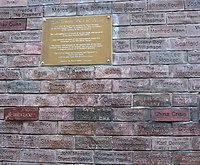
Tribute clubs exist in Dallas, Buenos Aires,[21] Wellington,[22] Exeter,[23] Costa Teguise in Lanzarote, and formerly in Tokyo and Adelaide.[citation needed] A similar looking club was also featured in the opening sequence of the film Across the Universe, in homage to the Beatles' beginnings, though the club's name was never mentioned. The footage for this scene was actually shot in the Cavern Club itself. The Cavern Club is the first playable location in The Beatles: Rock Band.
The Hard Rock Cafe restaurant and hotel chain owns the trademark to the "Cavern Club" name in the US. When the Hard Rock Cafe was built in Boston in 1991, it included a brick Cavern Club cellar that was a reproduction of the Liverpool club, including a stage for local bands. In 2006, the Boston restaurant moved to a new location, and although the new restaurant still has a "Cavern Club" performing area, it bears no resemblance to the Liverpool cellar. In 2014, a lawsuit was filed to revoke Hard Rock's trademark on the Cavern Club name.[24]
It also had a cameo in two John Lennon biopics, 2000's In His Life: The John Lennon Story and 2009's Nowhere Boy, as well as the movie Across the Universe.
The poet Roger McGough mentioned the club in his poem "Let Me Die A Youngman's Death": "Or when I'm 104 / and banned from the Cavern / may my mistress / catching me in bed with her daughter / and fearing for her son / cut me up into little pieces and throw away every piece but one."
Norwegian Cruise Lines have Cavern Clubs on four of their liners, the Norwegian Bliss, Norwegian Joy, Norwegian Encore, and the Norwegian Epic, which showcase Beatles tribute bands.[25]
See also
[edit]- Cavern Mecca, a museum that was next to the Cavern Club
- Iron Door Club
- List of the Beatles' live performances
References
[edit]- ^ a b c d e Note on first Beatles appearance, The Cavern Club.
- ^ Spitz (2005) The Beatles, p. 59.
- ^ Spitz (2005) The Beatles, p. 61.
- ^ Spitz (2005) The Beatles, p. 65.
- ^ Spitz (2005) The Beatles, p. 125.
- ^ "Ray McFall: Accountant who took over the Cavern club and gave the Beatles the break that set them on course to rule the world". The Independent. 9 January 2015. Retrieved 26 October 2020.
- ^ Where it all began..., The Cavern Club, archived from the original on 6 January 2009, retrieved 9 January 2009.
- ^ Explicatory plaque commemorating the refurbishment of the substation in 1998 as a public work of art.,
This Manweb substation was refurbished during 1998 as part of Manweb's commitment to the community. / The transformation into a work of art, day and night, was switched on by Gerry Marsden on 1 December 1998. / The project was sponsored by Manweb with contributions from the Cavern Quarter Initiative and Mersey Partnership.
See also photograph. - ^ "Yellow submarine stars in light show" (PDF). Contact. Manweb. January 1999. p. 3.
WE all live in a yellow sub-station – the Manweb substation at Mathew Street in Liverpool has been turned into a phantasmagoric evening light show featuring a Yellow Submarine as part of the renovation of the Cavern Quarter made famous by The Beatles.
- ^ Olivia Williams (26 October 2019). "The future of Cavern Walks: former WAG haven that fell out of favour". Liverpool Echo.
History of the Cavern Walks Built in 1984, the shopping centre was reopened alongside an authentic reconstruction of the Cavern Club and soon became the place to go to buy designer clothes and sip on fancy coffee.
- ^ "Back To Where The Beat Began". .Good News Liverpool.
.Jan Akkerman with Dutch group Focus were the last to play The Cavern, a few days before the club was shut down in May 1973.
- ^ "History: 1970s". Cavern Club.
1972 – British Rail took ownership of the warehouse block 8-12 Mathew Street which housed the original 1957 cellar vaults of the Cavern Club, ... The plan by British Rail was to clear that part of Mathew Street to build a ventilation shaft for the city's new underground railway loop. / Tuesday 5 June 1973 – Bulldozers moved in to start the demolition of the warehouse buildings that housed the world famous Cavern Club in Mathew Street. / Although the buildings at street level were demolished, the original cellar was not destroyed, only filled in with the rubble from above. The proposed ventilation shaft was never built and the site of the Cavern Club became a rough surface street level storage area for British Rail vehicles before becoming a car park.
- ^ "History: 1990s". Cavern Club. Cavern City Tours Limited.
11 July 1991: Cavern City Tours re-opened the Cavern Club and continued to provide the disco music which had been so successful under the previous owner. / Within a month the Cavern was open six days and three nights to cater for the growing visitor and tourist market. / The new owner's aim to bring back live music to the Cavern didn't happen immediately.
- ^ Taysom, Joe (18 June 2020). "Revisiting Arctic Monkeys first-ever tour stop at Liverpool's iconic venue The Cavern". Far Out Magazine. Retrieved 26 October 2020.
- ^ "Teenage sensation performs secret intimate gig in The Cavern". Liverpool Echo. 7 November 2013. Retrieved 26 October 2020.
- ^ Cavern Showcase, retrieved 31 December 2008.
- ^ Cavern club removes Glitter brick, BBC News, 15 November 2008, retrieved 31 March 2009.
- ^ "CELEBRATE 60 YEARS OF THE CAVERN!". Cavern Club. 4 October 2016. Retrieved 4 November 2016.
- ^ "Cilla Black statue unveiled as Cavern Club celebrates 60 years". BBC News. 16 January 2017. Retrieved 18 January 2017.
- ^ "Cilla Black statue unveiled at Cavern Club's 60th anniversary". Sky News. 16 January 2017. Retrieved 18 January 2017.
- ^ "The Cavern Buenos Aires". The Carvern. Retrieved 9 March 2018.
- ^ "Cavern Club, Wellington NZ". cavern. Retrieved 14 August 2019.
- ^ "HOME". exetercavern.com. Retrieved 14 August 2019.
- ^ "Cavern Club fights Hard Rock Cafe over US naming rights". BBC News. 14 May 2014. Retrieved 27 August 2015.
- ^ The Cavern teams up with Norwegian Cruise Lines for a 2nd time, June 1, 2018, https://www.cavernclub.org/latest-news/the-cavern-teams-up-with-norwegian-cruise-lines-for-a-2nd-time
- Bibliography
- Spitz, Bob (2005). The Beatles: The Biography. Little Brown & Company. ISBN 978-0-316-80352-6. (2005) / (2005) / (eBook in 2012).
Further reading
[edit]- Spencer Leigh, The Cavern: The Most Famous Club in the World, The Story of the Cavern Club, SAF Publishing, 2008, 224 pp. ISBN 978-0946719907
- Phil Thompson, The Best of Cellars : The Story of the World famous Cavern Club, The Bluecoat Press, 1994, 208 pp. ISBN 978-1872568164. Rev. & upd. ed. by NPI Media Group, 2007, 192 pp, ISBN 978-0752442020
External links
[edit]- Cavern City Tours
- "Cavern Celebrates 50 Years". BBC Liverpool. 18 January 2007. Archived from the original on 13 April 2014. – Cavern Club at fifty
- 'Premier At The Cavern' – 1966 newsreel Archived 8 July 2011 at the Wayback Machine
- Cavern After Hours for many images of 1960s groups that never made it big and other rare items of interest.

